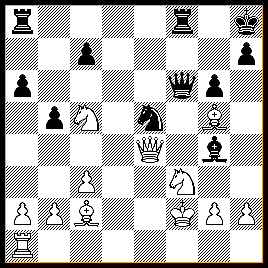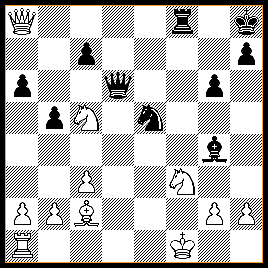Book Reviews by Sam Collins
 The turkey has been scoffed, the party hats cast aside and the Christmas cracker jokes read out to the pained groans of immediate family members... that’s right, Christmas has gone. The turkey has been scoffed, the party hats cast aside and the Christmas cracker jokes read out to the pained groans of immediate family members... that’s right, Christmas has gone.
It your list of New Year Resolutions contains the sentence “Learn something new against 1.e4”, consider Open Ruy Lopez by Glenn Flear (Everyman Chess, 159 pages, R.R.P. £14.99) as a good way to spend those festive book tokens; indeed, Grandmaster Flear appears to have done a very nice job.
Flear is well-qualified to write this book; he is a strong player (as the “GM” before his name indicates) who plays the opening himself, and is an experienced author, having flexed his theoretical muscles in New Ideas in the QGA and The Slav for the Tournament Player (both by Batsford), for example.
The book is beautifully presented, with a short Preface and Introduction followed by twelve chapters explaining everything after 1.e4 e5 2.Nf3 Nc6 3.Bb5 a6 4.Ba4 Nf6 5.0-0 Nxe4. The material is very well laid out in 88 well annotated illustrative games (many played by the author himself- a nice bonus), plenty of diagrams and concise chapter introductions and summaries. In the introduction, Flear lists typical strategies for both White and Black, and gives game numbers to show where these ideas can be seen... a suberb idea, and (in my opinion) much more effective than the grudgingly set-aside couple of ‘theme paragraphs’ at the start of most opening books, from which the reader is expected to gain a full positional command of the opening under discussion. As is customary, Flear offers the “Index of Complete Games” as a tool for readers to gain fast access to a specific game... but I have always thought that, particularly in an opening book designed mainly for Black players, a simple “Player Index” should be used... when I want to see Yusupov playeing beautifully on the Black side of a Lopez, why should I have to look up Wang Zili ( i.e. Wang Zili-Yusupov,Novi Sad Olympiad 1990)? Okay, minor point... let’s get on to the bigger issues in this book.
Open Ruy Lopez is a complete opening survey rather than a repertoire book (for instance, after 6.d4 b5 7.Bb3 d5 8.dxe5 Be6 9.c3, Flear covers 9...Bc5 10.Nbd2 0-0 11.Bc2 f5, 11...Nxf2 and 11...Bf5, not to mention also dealing with 9...Be7). Flear devotes a chunky 98 pages (over 60% of the whole book) to the 9.c3 variation, and it is 98 pages well spent... his coverage is excellent, and any White players interested in learning how to play against this opening are advised to take a look. 9.Nbd2 comes a distant second with only 17 pages (this section also looks impressive, but perhaps, in view of the line’s popularity, Flear should have given it a little more space), with 9.Qe2, “White’s other ninth moves” and “Odds and Ends” making up the 157 pages. I think that Flear has maintained admirable depth, considering that he deals with every significant variation in a relatively short opening manual (the print is small, which helps); even so, I think that the book should have been longer (for example, Flear only gives 10 pages to 9.Qe2, despite labelling it “the most difficult to meet”; I understand that there isn’t so much theory on this line, but a little independant analysis would have been particularly welcome here).
I don’t have any major complaints about this book, but I did spot a couple of slip-ups.
For intance, in his annotations of the game Karpov-Yusupov, Ussr Ch., Moscow 1983, Flear concludes “it seems that Black doesn’t quite equalise after 16.Nd2”, while failing to mention any of the improvements proposed by Yusupov (23...Rb6!, 23...Ra4!?, and 25...Ra4!), all of which, according to Yusupov’s analysis, equalise! The interested reader can find the relevant analysis in Training for the Tournament Player (Batsford) by Dvoretsky and Yusupov. I don’t think that Flear should be criticised too harshly for this; in general, his references are very good, and no one can be expected to have read every book ever published, but I find it curious that no one in the editing process pointed out Yusupov’s notes... and the following resource should have definately been noticed by the editors (and by Flear as well, of course).
Flear, eager to showcase his analysis, gives a diagram to the position after 9.c3 Bc5 10.Nbd2 0-0 11.Bc2 Nxf2 12.Rxf2 f6 13.exf6 Bxf2+ 14.Kxf2 Qf6 15.Nb3 Ne5 16.Nc5 Bg4 17.Qxd5+ Kh8 18.Qe4 g6 19.Bg5

and comments “19.Bg5!!, my own clear improvement on the theoretical recommendation {here he gives a line leading to equality}, and if 19...Qxg5, then 20.Qxa8.”. But, on looking at this position, I couldn’t help but wonder...what happens after 20...Qd2+ ? Since 21.Kg3 loses to 21...Qf4+, the forced continuation seems to be 21.Kf1, but then 21...Qd6

and I don’t see how White improves on the line 22.Ne4 Rxa8 23.Nxd6 cxd6 where, considering that on 24.Rd1 Black seems to hold with 24...Nc4!, Black maintains a playable slight disadvantage. This is exactly the kind of line which could trip up the reader during a game, particularly when he has been led to believe that 20.Qxa8 simply wins, and not mentioning this resource was careless.
The fact remains, however, that Open Ruy Lopez rises above the average opening manual available today. Glenn Flear has given a lot of good theory and excellent grandmaster assesment of many positions encountered along the way, and produced a very good book.
My assessment: * * * *
Other reviews by Sam Collins
Review 1: Play the Open Games as Black, by John Emms
Review 2: The Human Comedy of Chess: A Grandmaster’s Chronicles by GM Hans Ree & Storming the Barricades by GM Larry Christiansen
Review 3: Open Ruy Lopez by Glenn Flear
Review 4: Main Line Caro-Kann by Neil McDonald
Review 5: Offbeat Spanish by Glenn Flear
Review 6: Excelling at Chess by Jacob Aagard
Review 7: Can You Be a Positional Chess Genius? by Angus Dunnington
Review 8: The Grunfeld Defence by Nigel Davies
Review 9: The Best of Chess Cafe
Review 10: How To Build Your Chess Opening Repertoire by Steve Giddins
Review 11: The …a6 Slav by Glenn Flear
Review 12: Starting Out: The Ruy Lopez by John Shaw
Review 13: Knockout Nimzo (video) by Tony Kosten
Review 14: My Great Predecessors by Gary Kasparov
|


